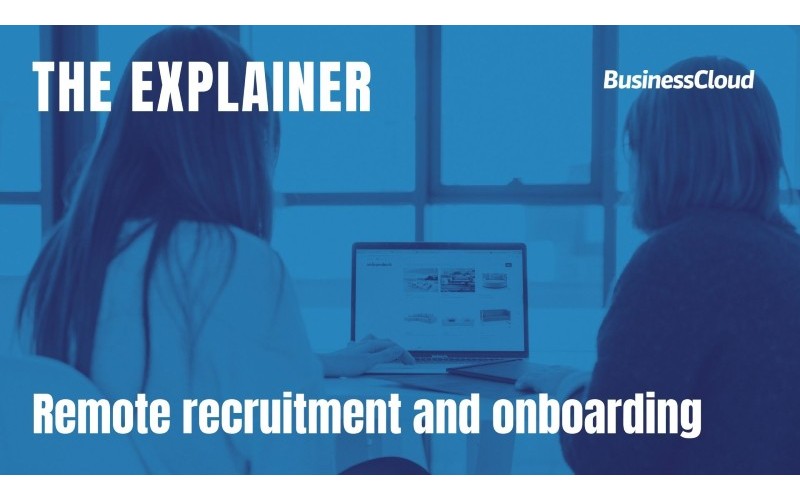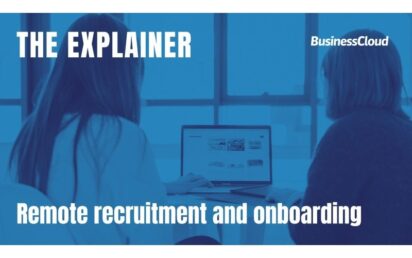When the UK entered the grip of its first lockdown a year ago, companies raced to set up team members to work from home as a ‘new normal’ of remote work took hold.
As the dust settled and many began to look to the future, established methods of recruitment and onboarding went out the window.
In the tech sector, where companies can grow at an incredible rate, hiring practices are especially important – but then these start-ups are already amongst the savviest around when it comes to virtual communication.
With this in mind, six figures explain the most efficient ways to recruit, onboard and train team members remotely.
Should I lower or change my expectations?
Colin Hewitt is the CEO of Float, a cash flow forecasting tool for small businesses which has recruited more than 12 people since the onset of COVID-19. “We’ve found that the process is going to naturally take longer,” he tells BusinessCloud. “There are certain things you pick up in a real–life interview that you might miss over a video or voice call.
“By setting the expectations that the process will take longer and have more interviews than they might expect, you can avoid people feeling lost during the process and dropping out.”
What processes should I have in place?
“We learned a lot throughout the process and have managed to refine it along the way too,” Hewitt says of his company’s hires. “My first tip would be to set out the process clearly from the start, for both you and the candidate, so you both know what to expect.
“During the pandemic, our recruitment at Float has been completely remote, so we’ve added several steps to the process – from that initial getting-to-know-each-other call, through to the various tasks we set candidates.
“Try to have plenty of touch points with different people to make sure you’re getting as clear a picture as possible. When you’re ready to make an offer, be sure to have the practicalities ironed out – everyone will have different expectations and needs when working from home, so it’s good to set those expectations about core hours, and which team meetings are necessary to attend.”
Eben Lovatt, CEO at car leasing site Moneyshake, says the ‘give it a go’ start-up mentality at the firm felt under threat by successive lockdowns.
He advises: “The first thing you need to do before starting new recruits is check that the processes of each department are clearly documented.
“When you’re not in the office, it’s difficult for people to ask where to find things or how to perform a task. However, if an experienced member of each department creates a document of key processes for the relevant new starter, you can avoid this headache.”
What should I be looking for in a candidate?
Tom Lawson, CEO at Opencast Software, says firms should recruit for culture and capability with equal weighting.
“Recruiting during a pandemic can be difficult, but it is still essential to ensure that any potential employees have the right culture fit, as well as the right capability fit,” he says. “The truth is that skills are easy to learn, but personality traits are harder to change.
“Businesses should consider placing questions or tasks into the interview that really test what the candidate’s personality is like. For example, setting ‘unexpected’ tasks that fall outside applicants’ expertise can allow the senior team to examine how the candidate responds to situations like these.
“It goes without saying that it’s also imperative to consider how the candidate will work with the rest of the team.”
Jess Thurston, marketing executive at recruitment firm Maxwell Bond, says now is a good time to hire. “Many businesses are enforcing recruitment freezes and making redundancies, so now is the perfect time to hire premium talent without the premium price tag.
“Whilst we understand, that for some businesses, recruitment simply isn’t a financially sound plan right now, there are other ways to prepare for when everything returns to normal. This includes planning ahead and setting up talent pipelines, so when you’re given the green light to start recruiting again, you can hit the ground running.”
Emma Barry, co-founder and chief creative soul for Good Soul Hunting – which ‘recruits executive go-getters for purpose-driven health and fitness companies’ – says the end–game is ‘phygital’: physical plus digital.
“People remain our greatest asset… in fact, they are even more critical now to overcome the challenges of the pandemic, harness the opportunities, and out-win competitive efforts,” she says. “When recruiting for key roles, defining questions to ask are: Has this person been where I am going? Are they well-versed in phygital? What will they bring to the table? Can they accelerate our efforts? Am I settling for the close and convenient?
“You’ll no doubt have a list of technical skills to tick off when bringing in your next recruit, but it’s worth considering how well that person understands the symbiotic relationship between the physical and digital as we head into the phygital age and which elements from each they’ll tap to get the job done best.
“We are in blended times, meaning we’ll see a rise in talent being brought in from outside our respective sectors, as business leaders around the globe search for the people that can help them transition into the phygital age. And with geographical boundaries evaporating in the tech revolution, it’s entirely possible that the teams of the future – especially in digital and remote careers – will be global. The right people are out there, but are you taking a too narrow and simplistic view of recruitment?”
How can I integrate new starters into the team?
Maxwell Bond’s Thurston says one of its clients, an eCommerce giant, is setting an example to follow.
“Missguided are shooting ahead by adapting to the current climate. They are continuing to interview and on-board their planned new-starters, adapting to a virtual way of working,” she explains. “This has so far included video interviews, including a virtual office tour, and allowing their new hires to start on time, immediately working from home.”
Float CEO Hewitt is keen to see new starters connect across the business, which is obviously more difficult when you are not face-to-face in an office environment.
“Make sure they meet lots of people from all different parts of the business, as well as the people they’re going to be working directly with,” he says. “We’ve really refined the remote onboarding process to help anyone new get up and running and quickly feel a part of the team.
“Codify your onboarding process: having a clear structure and plan for those first few weeks can really help your new employee hit the ground running. This is particularly important for remote onboarding, as we don’t have the usual environment and infrastructure available to help them settle in.
“Putting together a welcome pack can be hugely beneficial for someone fresh in the door, and it’s particularly important to make sure that welcome pack has been updated to reflect the current climate. Setting up meetings with the wider team helps everyone put names to faces and ideally gives them an instant sense of belonging.
“We’ve found using an HR system called Charlie HR incredibly helpful. It’s a place where we can centrally store important documents and new recruits can explore the company org chart and view the people directory.
“Finally, I’d recommend having a buddy system in place for new team members. This means there’s someone there for the new recruit to check in with at the start and end of the day during their first week and gives them a point of contact for any questions or issues they have.
“Recruiting remotely is challenging, but it isn’t impossible. With the right systems in place, you can onboard new employees just as smoothly and effectively as you would have done pre-pandemic.”
Moneyshake’s Lovatt says virtual interactive inductions are vital. “It’s crucial that your new starters meet the rest of the team to ensure they get to experience the company’s culture.
“A face-to-virtual-face induction with all the team – or if it’s a big business, the colleagues in their own team – will help new staff feel engaged with the business.
“This way they won’t feel isolated and are more likely to be productive in their work.”
How should I manage staff going forward?
CEO Euan Cameron started up video interviewing software firm Willo in 2020. “Many of our users were thankfully still recruiting during the pandemic and what they found most valuable was being able to give candidates who were almost always at home, the opportunity to flexibly interview for jobs,” he says.
“Ironically, it is much harder for candidates to apply for jobs when they are stuck in the house with childcare issues and lots of distractions. Using a platform like ours gives businesses a flexible way of connecting with candidates wherever they are located, and on their terms.
“We are at the beginning of a remote workforce revolution and any business recruiting in 2021 should be open to recruiting the best people wherever they are in the world.”
Barry points to the importance of communication tools. “The pandemic has, as far as digital advances are concerned, fast-forwarded us by about a decade. Digital methods of doing things have now been adopted as a part of daily life – both in professional and personal spheres.
“Just consider the transformation of doing business over the past nine months, with the rapid explosion of video conferencing, virtual workspaces, and platforms such as Slack owning communication. Nothing super techy, but enjoying massive adoption rates.
“Regardless of what industry we’re in, we’ve all had lifestyle changes and redefined new ways of living and working. NASA even managed to land a rover on Mars during the pandemic, with many of its scientists, engineers and technicians working from home in the build-up.”
Lovatt is an advocate of workflow management tool Trello. “A great way to avoid micromanaging your new colleagues is to introduce them to project management tools such as Trello. This allows you to set up a central ‘hub’ where anyone with access can view and manage ongoing projects.
“Descriptions of the work, due dates and briefs can be attached. Everything is documented, so you know if and when tasks are completed. But your new starter has the autonomy to get on with their work, without feeling like they’re not being trusted.”
Thurston advises: “Trust all staff, including new starters, to work effectively from home. Provide support and all login details so they are fully equipped to hit the ground running. This means no working delays and projects can run on time.
“It can be hard working in isolation, and it’s important to still have social interaction, which can include calls and video calls with other colleagues which have no work agenda.”
What should my approach to training be?
Opencast Software CEO Lawson says companies should promote a culture of learning that reinforces the company’s vision.
“As a company’s priorities change – as they have done during the pandemic – it’s important for businesses to adapt very quickly. In many cases, that may require the upskilling or reskilling of employees.
“Investing in employee training will not only enable businesses to pivot to meet changing market demands, but will also help to create a culture of learning.
“It is not uncommon for business leaders to overlook training for existing staff and to focus on new recruits instead. However, to maintain staff engagement, it’s vital that staff are able to enhance their existing skills whilst learning new ones.”


